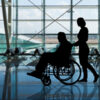The usual default for medical transportation is ordering up an air ambulance.
When patients, families, hospitals find themselves in a situation where a patient with a medical condition requires long distance transportation, one of their first thoughts is to contract a private medical jet. Often, air ambulances are a good option. However, in this paper we argue air ambulances are frequently NOT the best option. Conducting medical transports on commercial airlines will often provide the safest, most cost-effective and comfortable alternative to most air ambulance services.
There are many situations when a patient may require transportation over long distances. New medical issues [e.g. heart attack, stroke], exacerbations of existing issues and injuries [think car accident] can wreak havoc to a person’s travel plans. If such an event results in a permanent disability or the need for extended treatment, most patients will opt for returning home rather than remain in a distant location for a protracted amount of time. Some patients will choose to travel after they have been diagnosed with a medical condition to seek treatment at an alternative location. This can be driven by the desire to try alternative or highly reputable treatments that are not available locally. Others seek to travel when out of pocket expenses are being incurred, to seek care at a lower cost. Other patients, who expect to have a protracted recovery period or are in generally declining health, may chose to travel to be closer to family members or other social support networks.
There are some general assumptions the lay public has regarding air ambulances; some are accurate, others are not.
To delineate the detractors first:
Most air ambulances are small aircraft with limited capacity and range. They can accommodate a stretcher, are outfitted with oxygen and can accommodate medical attendants. But they cannot accommodate much else. Patients will not be taking large amounts of luggage, equipment [e.g. wheelchairs] or multiple family members along. There are limitations in the distance traveled between fuel stops (generally about 2000 miles). This creates the need for frequent refueling over long distances. So, where a large commercial airliner may fly directly from points in Asia to New York without stopping, a smaller air ambulance would need to stop multiple times for fuel and take a round-about course. This also creates the need to preposition additional flight crews in order to swap out the pilots to overcome crew duty day restrictions. There is no lavatory on most air ambulances, no running water and the patent is often confined to the stretcher, even if they have partial or full mobility.
Air Ambulance Positives:
Air ambulances are able to file unique flight plans, so they can fly point to point, from near the patient's location to near the desired destination. This allows them to fly into and out of some areas that are not serviced by commercial carrier hubs, assuming that a suitable runway is available. Time urgency is another good reason to use an air ambulance -- they can be arranged in a matter of hours in most cases so they are ideal for patients with time sensitive, critical conditions. Unlike commercial airlines, they can maintain sea-level equivalent cabin pressure. This ability comes with costs – to maintain the higher cabin pressure, they must fly at a lower attitude, at a slower speed, with shorter distances between fuel stops. This translates into higher monetary costs. These costs are, of course, passed onto the end consumer.
Most people do not consider commercial airlines as a viable alternative to air ambulances. They [correctly] feel that the logistical challenges of arranging a commercial flight and then navigating through airports and security are daunting for many ill or injured patients. They feel that their medical conditions preclude them from traveling commercially. They may be confused about how to administer newly required medications or oxygen. They often envision themselves stuck in an economy seat with no room to take care of themselves. With the appropriate assistance though, these challenges are easily overcome. Commercial transportation is a good, oftentimes better alternative to using an air ambulance.
Most long-range international flights now have business and/or first class seating which is able to recline to a fully flat position. Increasingly, these seats are being seen on some longer domestic routing as well. These seats offer at least the same level of comfort as the best air ambulance stretcher. The seats are also adjustable and the patient is able to manipulate their positioning at will. The patient must be able to sit upright during takeoff and landing as the restraint systems in these seats are not fully functional when in the flat position, and a reclined seat may interfere with other passengers' ability to exit the aircraft in an emergency. There is the added advantage of being in a large cabin – so there is room to get up and move about if the patient is able. They can utilize the privacy of a real lavatory. They can order a variety of meals. There is entertainment available.
Some international airlines still provide a stretcher option for patients. In most cases, this requires the purchase of 6-9 economy seats which are then folded forward and a stretcher is bolted to the armrests of the seats. This is not an option on US carriers.
Lufthansa has an added option. A small, private cabin with extensive medical equipment is built into the middle section of a wide body jet and the patient is provided with ICU level care while in flight. This is only available on certain routes. While more expensive that other forms of commercial medical transportation, it is usually much less expensive and certainly faster than the air ambulance alternative.
Many patients require oxygen for travel. Some airlines will still provide oxygen cylinders for a passenger’s use upon request (sometimes requiring a prescription). More and more frequently however passengers are expected to service this need on their own in the form of an airline-approved portable oxygen concentrator. This is a better alternative to onboard oxygen cylinders. They are versatile, can be carried on the person, and allow the patient to mobilize as needed as they travel via ground and are in transit to and from the aircraft.
Whether the patient is flying in a regular seat or on a stretcher, arrangements need to be made with the airline anywhere from 2-7 days prior to travel. Most airlines require medical clearance. A physician must complete forms which describe the patient's condition and they must specifically address aspects of their condition which could be adversely affected by the flight environment.
Commercial airlines are accustomed to transporting passengers with medical needs. Most airlines have medical departments and/or medical control that are accustomed to patients and their myriad medical issues. Their personnel are trained in aerospace medicine and are often asked to confirm that patients are safe to fly; these are not new issues to them. The information provided to them by the treating physicians is reviewed by the airline medical staff and clearance to fly issued if appropriate. It is worth noting that for US carriers, because of the airline equivalent to the "Americans with Disability Act," the airlines do their utmost to accommodate all passengers as long as there is no risk to the flight or other passengers.
In addition to arranging for the tickets and clearances, patients flying on commercial airlines will usually need some assistance getting to the airport and then through the airport to the aircraft. At some airports, it is possible to bring an ambulance all the way to the aircraft, while at others, the patient must go through the airport to reach the gate. This can be done via wheelchair or even via ambulance stretcher in some cases.
Many patients will require a medical escort to travel with them to monitor their status, assist with navigating the airport and provide and required treatments/medications en route. Among this subgroup are hospitalized patients, patients requiring IV medication administration, those with cognitive disturbances, and those requiring more assistance with mobilization or needing any other help with activities of daily living. These escorts are usually nurses or physicians who are familiar with the unique environmental factors associated with air travel and how these factors affect various medical conditions.
Our Conclusion:
From a patient's perspective, when there are at least a few days to make arrangements, commercial travel is a viable [and often superior] and cost effective alternative to air ambulance transport. When all the necessary pre-planning, clearances and pre-arranging are done by a third party, and there is a medical escort to navigate the logistics of travel and provide in-flight medical care, the entire transport experience is usually more positive for patients choosing commercial medical transport over a traditional air ambulance.







